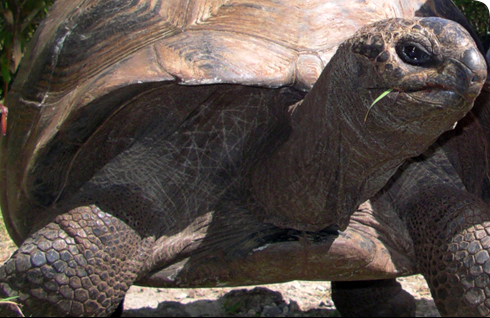Geochelone gigantea (Aldabra giant tortoise)
Geochelone gigantea, the Aldabra giant tortoise, is one of the largest tortoises in the world.
The Aldabra giant tortoise lives on the remote Aldabra atoll, one of the Seychelles group of islands in the Indian Ocean.
The Aldabra giant tortoise's current IUCN conservation status is 'vulnerable' to extinction.
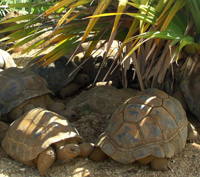
Tortoises and babies seek the shade of Pandanus trees at La Vanille Reserve. © L Steel
Many giant tortoise species around the world have become extinct due to
- hunting
- habitat loss
- introduced predatory species such as dogs, rats and pigs that eat tortoise eggs and babies.
The Aldabra tortoise almost suffered the same fate, but its plight was recognised just in time, and its bleak Aldabra atoll home is now a World Heritage Site.
However, the Aldabra atoll is only a few metres above sea level so the wild tortoises are now being threatened by climate change and rising sea levels.
To aid conservation, the giant tortoises are also being bred in captivity in reserves on the islands of Mauritius and Rodrigues, where they are thriving.
Species detail
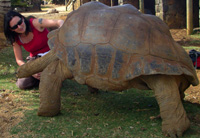
The author and a large Aldabra tortoise at La Vanille Reserve, Mauritius. © L Steel
Aldabra giant tortoises are slow-growing but large:
- Males grow to approximately 48 inches (1.2m) in length and weigh around 550lbs (250kgs)
- Female tortoises are a little smaller at 36 inches (0.9m) long and weigh around 350lbs (160kgs).
Giant tortoises live long lives. It has been claimed they can live over 250 years, however it is hard to be certain exactly how long they can live.
-

Taxonomy
Find out about the organisation that is reviewing the taxonomy and systematics of the Indian Ocean giant tortoises. Discover what recent genetic studies have revealed about the Aldabra giant tortoise.
-

Distribution and habitat
Find out about the types of habitat enjoyed by the Aldabra giant tortoise on the Aldabra atoll.
-

Biology
Learn more about the life expectancy and mating rituals of the giant tortoises.
-
Habitat Conservation
-

Conservation
Discover why many species of giant tortoise have become extinct and learn how this has, to date, been avoided with the Aldabra tortoise. Find out the threats facing the Aldabra tortoise as well as where you can visit the species and how you can help ensure its ongoing survival.
Images
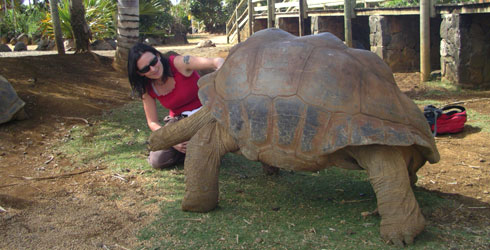
The author and a large Aldabra tortoise at La Vanille Reserve, Mauritius.
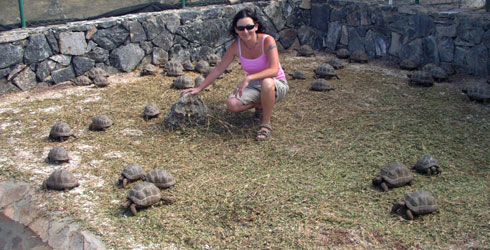
The author and lots of baby tortoises at the Francois Leguat Tortoises and Caves Reserve, Rodrigues.
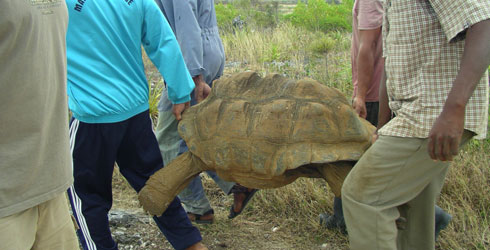
The arrival of the tortoises at the Rodrigues reserve. A large one is carried by four men.

A baby tortoise at the Francois Leguat Tortoises and Caves Reserve, Rodrigues.
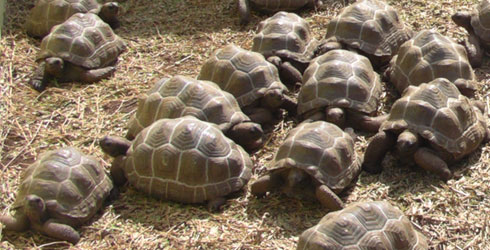
Baby tortoises at the Francois Leguat Tortoises and Caves Reserve, Rodrigues
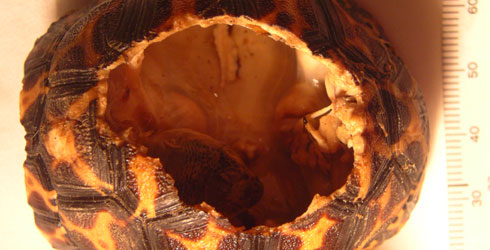
Shell of a baby radiated tortoise that was eaten alive by a rat.
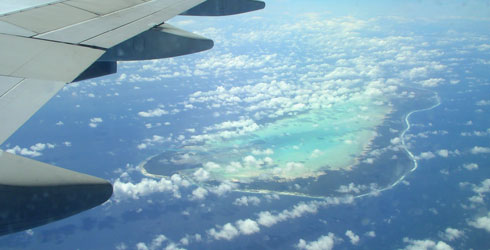
Aldabra atoll from the west.

Ile-aux-Aigrette, an islet just off the south-eastern coast of Mauritius. Here, introduced species such as rats and goats have been eradicated and native species are thriving. Aldabra tortoises have taken the place of the extinct Mauritian ones.
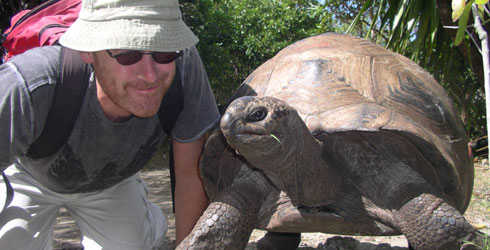
Julian Hume and a friend at Ile-aux-Aigrettes, Mauritius.
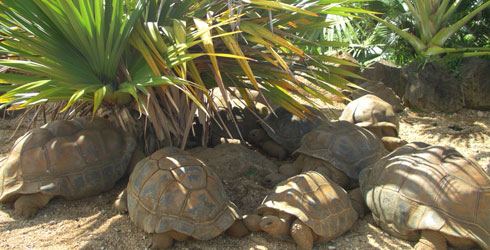
Tortoises seek the shade of Pandanus trees at La Vanille Reserve.
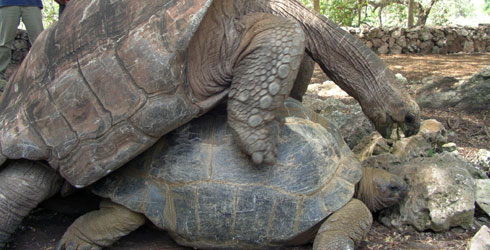
An old male tortoise called 'Foetidia' wastes no time in getting acquainted with his new friends in the Rodrigues reserve, after spending 90 years as a single captive male.

Ebony seedling germinating in tortoise poo at Ile-aux-Aigrette, Mauritius.
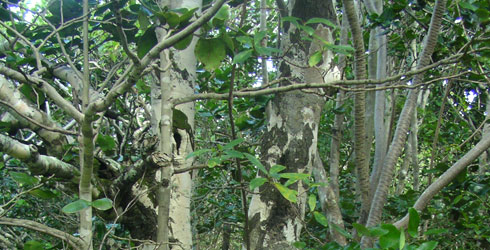
Ebony trees on Ile-aux-Aigrettes, Mauritius.
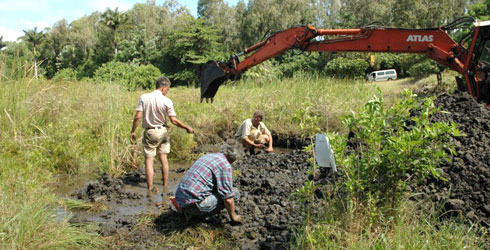
The Mare-aux-Songes, Mauritius, in 2006. The Dutch team begin excavations.
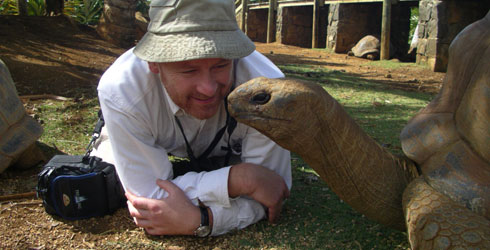
Julian and friend at La Vanille Reserve, Mauritius.

Julian Hume and baby tortoises at the Francois Leguat Tortoises and Caves Reserve, Rodrigues.
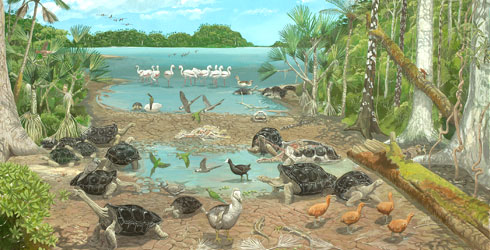
The Mare-aux-Songes, Mauritius, 4000 years ago. Reconstruction by Julian Hume.
Synonyms
- Testudo gigantea
- Dipsochelys elephantina
- Dipsochelys dussumieri
- Aldabrachelys gigantea
About the author
Toolbox
IUCN Conservation status
Vunerable
A taxon is Vulnerable when it is not Critically Endangered or Endangered but is facing a high risk of extinction in the wild in the medium-term future.
Find out more about the IUCN criteria for conservation status categories
